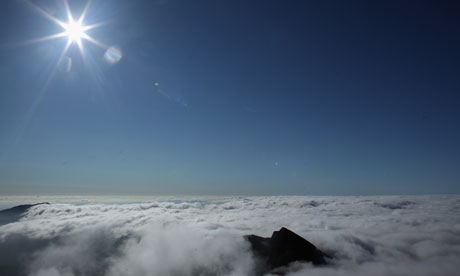
Stand at the summit of Snowdon on a clear day and you can gaze across the Irish Sea. But the volunteer mountain rescue team has had a record 103 call-outs so far this year as climbers get into difficulties while ill-prepared for inclement weather in a summer where mist and rain have frequently obscured the view.
Temperatures at the summit have on occasion fallen to 5C (41F). Last year, the Snowdonia National Park Authority counted 404,188 visitors – 71,056 of them in August. It represented a slight dip on the 2010 figure of 430,258.
The park's warden, Gruff Owen, said the summer weather of 2012 had been as bad as he could remember in recent years. The consequent record number of mountain rescue callouts had made it the busiest in the UK.
"This summer, more than any other I remember, we have had temperatures of 5C on the summit. Towards the end of June there was a chance of wintry showers. It has been a lot colder than usual."
He said the warden of the Countryside Council for Wales, which monitors rainfall on the mountain, said there had been no significant difference in rainfall in 2012 compared to the previous five years. It just felt as if it had rained more.
The volunteers from Llanberis mountain rescue team have had an exceptionally busy seven months, with 103 rescues. In the whole of 2011, there were 183 call-outs on Snowdon and 2012's figures are on track to be higher. Of the hundreds of thousands of people who walk there every year, the vast majority of visits are incident-free.
Owen says quite often people wondering what do for the weekend think about going to Blackpool, Alton Towers or Snowdon. "They turn up at the bottom wearing the same stuff as if they were going to Blackpool or Alton Towers," he said.
"I've seen people in pyjamas hundreds of times. I've seen people dressed in superhero outfits or dressed up in skintight Morph suits. And we've had emails from people asking if they can walk up Snowdon in a mankini."
Now the Mountainsafe partnership, including the Llanberis team, the park authority and North Wales police, has taken an initiative to improve safety. In a trial, discs giving grid reference points are being fixed on stiles and gates to help walkers who have become disorientated pinpoint their location on a map.
John Grisdale, the chairman of Llanberis mountain rescue team, said he was concerned about groups of walkers who were ill-prepared for the mountain environment. He said: "The potential of mishap increases greatly if conditions are less than perfect and the mountain rescue team has been called to several cases of novice mountaineers who have met with less than perfect conditions".
This month, Grisdale and his team encountered a stag party who were tackling the mountain in pyjamas during very heavy rain and strong winds. Advised to rethink their plans, the party ignored the advice but thankfully had not needed help.
The Llanberis team is among the busiest mountain rescue groups across the UK. In the Lake District, the Langdale and Ambleside team tackles more than 100 incidents annually. So far this year, it has attended 48 incidents. On 20 June, a woman died of her injuries after a fall at Jack's Rake in Langdale Fell. The team were returning to base after the fatal incident when they were called out again to another injured walker.
In Snowdonia, earlier this month, in six hours the Llanberis team dealt with three separate incidents, including guiding a group of 11 walkers down after they became lost. They say the pressure on the mountain is "extremely high".
A 15-year-old girl was airlifted to hospital with a head injury after being hit by a falling rock while walking on Watkin path, Snowdon, last Tuesday. She was winched aboard an RAF Sea King helicopter and taken to hospital in Bangor. There is no suggestion she was not prepared for the conditions.
Also last week, the team spent nine hours searching for a father and his 11-year-old son. The missing pair, from the West Midlands and poorly equipped in shorts and trainers, were found on steep and dangerous ground near Bwlch y Saethau on the east face. They had set off at 2pm on Monday afternoon heading for the summit. They hit mist halfway and lost the path, calling 999 at 9pm. They were found at 3am and it took three hours to walk to safety.
Sixteen volunteers were involved in the rescue. It was the team's 100th call-out of the year and the second extended rescue in two days after badly planned excursions.
Figures from the Guardian's Datablog show the military responded to 1,921 callouts in 2011, down from 2,050 the previous year and nearly 500 fewer than in 2009, which was a record year. The busiest MoD unit was HMS Gannet, who performed 298 search and rescue operations moving 240 people in and around Scotland. RAF Valley, Prince William's base on Anglesey, moved the most people in 2011: 246 during 276 callouts. It is the nearest base to Snowdon. The MoD's next quarterly statistics on search and rescue operations are released on Wednesday.
The Mountainsafe initiative may be replicated in other mountainous areas of the UK, such as the Lake District. Owen said: "We don't want to be negative and put people off, we just want to make sure when they go out on Snowdon they are properly equipped."

